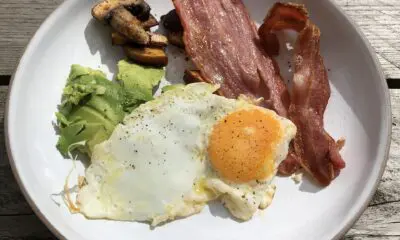WEIGHT LOSS
How to Make Losing Weight a Habit When You’re Busy and Unmotivated!
You need or want to lose weight ― but how can you do it when you’re tired, stressed, unmotivated, or navigating a packed calendar?
In our fast-paced modern world, open schedules are about as rare as healthy fad diets. You’ve got work, family, friends, bills, and responsibilities weighing you down. Is it possible to add a challenging new goal like weight loss?
Although it may sound daunting, weight loss is attainable for everyone ―yes, even you with the double-booked schedule. It’s all about making it a habit and working in small steps that build up to big goals. This guide will walk you through how to create weight loss habits that fit seamlessly into your life.
How to Form New Habits (and Break Old Ones)
The research on forming new habits is long and thorough, so let’s use scientific habit-forming techniques to achieve your weight loss goals.
Habits are a part of our everyday life. When we learn something new, it seems hard at first. But the more we do it, the easier it becomes. Soon, things we’ve done enough times become habits, and we hardly have to think about the steps involved.
Some habits serve us well, while others not so much. Maybe you have some habits that get in the way of your weight loss goals, like heading to the fridge whenever you’re stressed. Fortunately, you can break those bad habits and replace them with new, healthy habits.
The Habit Loop
In a book called The Power of Habit, the New York Times writer Charles Duhigg details the science of habit. He writes that our habits are created through a “habit loop,” which is a process that happens in three steps.
The habit loop starts with the cue, a trigger that puts your brain on autopilot and lets the habitual behavior start. Next, the habit itself occurs and maybe so routine that you hardly notice it. Finally, each habit loop ends with a reward. This cements the habit by giving your brain something to look forward to when the loop begins again.
For example, if late-night snacking is your poison, it may start with a cue like a stressful thought about your busy day tomorrow. Then, the habit itself is performed: You go to the cupboard and eat something unhealthy. Your brain tells you it enjoys the feeling of snacking, creating a reward each time you complete this habit loop.
Breaking Free
Breaking a habit isn’t as easy as just making a conscious choice to stop. Neuroscientists have discovered that the basal ganglia in the brain govern our habits. The basal ganglia are also linked to memory, emotion, and the ability to recognize patterns. However, it has nothing to do with decision-making: Your prefrontal cortex is in charge of that.
So when you engage in a habit, you’re effectively on autopilot. You aren’t deciding to carry out the habit loop, and the decision-making part of your brain takes a backseat.
To break a habit, you must disrupt the habit loop. To form new habits, you can intentionally create the loop. Change things up so you can’t start the habit on autopilot as easily. (Move your snacks to the basement, and you’ll think twice about reaching for them.) Meanwhile, attach a reward to positive behavior, and you’ll soon have a new habit loop forming.
When to Make Weight Loss a Priority
Is weight loss worth forming a new habit over? If your weight is getting in the way of your health and happiness, the answer is yes.
Everyone’s optimal weight is different, and it’s not healthy to base your weight loss goals on something like your BMI or an ideal jeans size. Consult with your doctor before starting a weight loss journey. They can help you figure out your ideal weight and rule out any underlying health factors that are making losing weight difficult.
If you and your doctor agree that shedding pounds is an important goal, then it’s time to create new habits that will help you reach your target weight. The hardest part is getting started. Once you cement these habits, the habit loop will take over, and you’ll start losing weight on autopilot.
Weight Loss Tips Anyone Can Handle
The key to forming habit loops for weight loss is starting with small, attainable steps and rewarding yourself for each one. Work these tips into your schedule one by one, and they’ll eventually become second nature.
1. Reduce your starch and sugar intake
Losing weight isn’t really about eating less. It’s about changing what you put into your body. Your first habit loop goal should be replacing your starchy, sugary go-to foods with healthier choices.
Fat was vilified as a weight-gain culprit for many years, but refined sugar is what you should watch out for. Take away the simple carbs and sugar, and you’ll automatically consume fewer calories, too.
2. Add fat, vegetables, and protein
Create balanced meals that include a source of healthy fats, protein, and low-starch vegetables, and you’ll feel full while losing weight.
Protein helps boost your metabolism, so you’ll burn fat faster, and it reduces cravings for food too. Eat as many low-starch vegetables as you want ― they provide you with minerals, vitamins, and fiber without contributing to weight gain.
3. Lift weights
If you follow steps one and two, you will lose weight. However, you can boost your results by adding exercise.
Something is better than nothing, but you should aim to lift weights at least three times a week… The great thing about weight lifting is that you don’t need a gym membership. You can buy one session with a personal trainer to learn form and technique, then pick up a few free weights to use at home.
However, if you find that it’s hard to stay motivated at home, going to the gym might be just what you need. Either way, make it a habit and you’ll see weight loss much faster than if you just change your diet. Weightlifting burns plenty of calories and speeds your metabolism.
If lifting weights isn’t possible for you, do cardio instead. Try walking, jogging, biking, or swimming.
4. Keep a food log
To take things up another level, get in the habit of writing down everything you eat in a daily food log. You can also keep an exercise log if working out is part of your weight loss plan.
A food log works wonders by showing you where your dietary choices are falling short. You might feel like you’re eating healthy, but not realize just how frequently you’re snacking, for example.
Keeping a food log will also give you the motivation to check in with yourself before eating. You’ll have to think about how your choices look once you write them down, which may prompt you to choose healthier foods.
Writing things down by hand helps some people stay committed to a food log. For others, a phone app is more convenient. Either way is fine ― just make sure you keep your food diary going for at least a couple of months so you can see your eating patterns develop.
5. Celebrate your achievements
Since the reward is the part of the habit, a loop is crucial to cementing a new habit, it’s important to factor reward into your weight loss strategy.
However, avoid tying your celebration to a number on the scale. Since weight fluctuates depending on all kinds of factors, you’ll get frustrated when the number doesn’t go down as fast as you’d like. Instead, find other achievements to reward yourself for.
Maybe you successfully kept a food log for a month or added a workout to your weekly routine. Reward yourself with a non-food-related treat like a manicure or a day trip. This will trigger your brain’s pleasure center, making it easier to keep your new habit going strong.
Customize Your Weight Loss Habits
Once you’ve mastered the art of the habit loop, you can develop new habits that will help you reach your ideal weight.
Reward good habits while breaking the bad ones by making the habit loop harder to start. The first few weeks may be difficult. But after that, your habits will start to crystallize, and your weight loss will happen on autopilot.
Looking for more ways to kickstart your weight loss motivation? Check out our top 10 motivating tips here.
Sources:
The Ketogenic Diet – Is It Right For You?, Defend Your Health (https://defendyourhealthcare.us/ketogenic-diet)
Habits: How They Form And How To Break Them, NPR (https://www.npr.org/2012/03/05/147192599/habits-how-they-form-and-how-to-break-them)
Functional Neuroanatomy of the Basal Ganglia, NCBI (https://www.ncbi.nlm.nih.gov/pmc/articles/PMC3543080/)
Why BMI Isn’t The Best Measure for Weight (or Health), Time (http://healthland.time.com/2013/08/26/why-bmi-isnt-the-best-measure-for-weight-or-health/)
How the Sugar Industry Shifted Blame to Fat, NYTimes (https://www.nytimes.com/2016/09/13/well/eat/how-the-sugar-industry-shifted-blame-to-fat.html?_r=0)
Gluconeogenesis and energy expenditure after a high-protein, carbohydrate-free diet, NCBI (https://www.ncbi.nlm.nih.gov/pubmed/19640952)
The effects of consuming frequent, higher protein meals on appetite and satiety during weight loss in overweight/obese men, NCBI (https://www.ncbi.nlm.nih.gov/pubmed/20847729)
Resistance training conserves fat-free mass and resting energy expenditure following weight loss, NCBI (https://www.ncbi.nlm.nih.gov/pubmed/18356845)

























